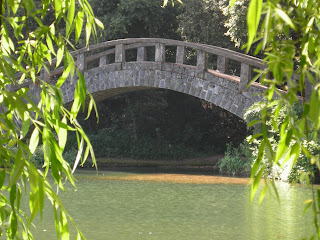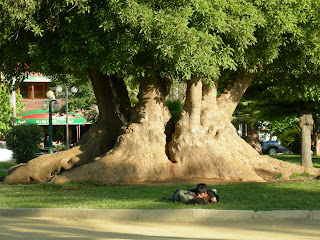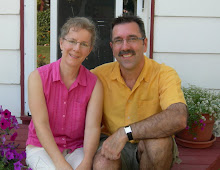I (Charlene) feel this is a good introduction to a magical place....Isla Negra....but, let me back up a bit.....
We awoke on Friday morning to a cloudy, damp, cool day. We had an early meeting with what we hoped to be (and has since turned out to be) a new student. After the meeting, we had planned to go on a day trip with our friend, Ines. Unfortunately, she had to cancel. So, because we were in "travel mode", we decided to set off on our own to see what we could discover. We had heard about Isla Negra, and because it wasn't too far away, we decided to go. The bus system is so easy and inexpensive, it's difficult to find reasons not to go exploring. So....we looked at each other and said "Vamos!!" (Let's go!)....
Bus tickets: Valparaiso - Isla Negra, 3,500 clp ($7.00) each, one way.

Isla Negra is about a 90 minute ride south and west of Valparaiso. San Antonio is the next significant town after Isla Negra. These are vineyards along the way.


Whenever we decide to go somewhere, there is always a bit of trepidation....."Will we like it?", "Will it turn out to be worth the time and the cost of travel?" As we set off from Valparaiso Friday morning, some of these thoughts were going through our minds. However, we weren't long out of the city before the clouds and rainy weather turned to sun and warmth. We knew no matter what.....it was going to be a good day, and it turned out to be one of the highlights of our time here in Chile. Also, I believe (and you may agree) that Norm did some of his best photographic work so far.
This shot was taken just as we were coming down the hill to the beach. The sun stayed with us for an hour or so, and then clouds and cool weather returned.

This shot is from the top of the hill where Neruda's house is located.
It gives a good panorama of the beach. In some of the video, you will see the Pacific washing over the rocks and then revealing them as small black islands. This is how Neruda came to name this place "Isla Negra". Gradually, the community came to accept this name, and its original name faded away.

When we saw the ocean before us, we felt completely mesmerized by the waves. We sat on the rocks and watched the waves roll in. Each time the waves came in, they were different. The colors of the water were different than we had experienced anywhere else, and the different shades of blue seemed to span the whole spectrum. We also noticed beautiful colors of green and aquamarine. It's difficult to describe what it's like to stand and watch the waves roll in. It was a windy day, and that made the "show" even more incredible. Every once in a while, an incredibly large wave would come crashing in. It was kind of like watching fireworks and waiting for the "really big one".
The following two pictures are favorites of mine. Norm really caught "the moment". If you expand these photos they are even more amazing. Looking at the second one, notice how the wind has swept the water off the tops of the waves. This made us think of winter on the prairies and the wind picking up the loose snow from the tops of the drifts.



The following photos show the the range of colors in the water......



If you listen to the audio, you may notice the voices of young people. There was a highschool group on the beach at the same time. We are thinking they came to see Neruda's house and then spend some free time on the beach. There was quite a large group of them, and as young people do, they were making a lot of noise. At one point, two young women (their teachers we assumed) came onto the beach calling them to "vamos". They did not look at all impressed when the kids "pretended" not to hear and they had to actually climb onto the rocks into order to get the kids to pay attention to them! It seems that kids are kids wherever you go. I was struck by how different this field trip was than what it might be like back home on the prairies. Maybe the kids here would think it was just another day at the beach and how boring it all was!



So now we are going to look at Neruda's house.....
This is looking up at it from the beach. It really doesn't look like much, but looks can be deceiving. He bought the property, and over the course of a number of years, he built the house as well as a number of outbuildings. With all of the extensions built onto the house, Neruda used to say that it was just like Chile . . . long and narrow. Isla Negra was his favorite amongst his four houses. He has been called an "avid collector of books, shells, paintings, wine.....and houses"!
Neruda was obsessed with the sea and, the interior of the house reflected his passion. Some ceilings were curved and slatted; some doorways narrow and rounded as would be found on a ship. It wasn't a mansion as one might expect from a wealthy national icon, but his home had a very interesting and welcoming feel to it.

We were extremely fortunate to have been at Isla Negra when we were. There were next to no tourists, and for a small extra charge, we were able to get our own private tour in English.
See the symbol on top of the house in the top left of the previous picture? This symbol has come to identify Neruda. Our guide said he designed the fish, but she seemed vague on the rest of the design. If you see this design on paper, the fish is in the middle of two circles, and around the outermost circle, Neruda's name is spelled out.

Neruda seems to have been somewhat of an eccentric. He collected many things such as glass bottles, bells from ships and churches, wooden stirrups (handmade, of course), African face masks, pipes, sea shells and well-endowed female figureheads that would adorn the front of huge ships. It would seem that he gave names to his figureheads and had favorites that he placed throughout his house. The following picture is of a boat that he owned; however as much as he enjoyed the sea, he was afraid to be on the water. So this boat sat on his property, and he would sit in it when he had friends who came to visit.

This structure shows the bells that he collected from ships and churches. Whenever he came to his home after being absent for a period of time, he would ring the bells so his neighbors would know that he was back and they could come to visit him.

Here I am looking into the bar. It was not possible to go inside unfortunately. You can see the glass bottles that line the shelves. Apparently too many of the bottles have been broken through the years, so tourists are no longer able to go inside. However, it was very interesting looking at these bottles. Every shape and size was there. Neruda used to go each Sunday to the flea markets in Valparaiso to find "treasures". He often would visit the sites of buildings that were being razed so he could find new pieces for his collections. Inside the house were many stained glass windows that he picked up from these sites.

I was really struck by the mosaic work that was around the property, both inside and out. Apparently, one of his artist friends designed and created these mosaics. I wish we could have taken photos inside the house as there was a beautiful mosaic that surrounded the fireplace in one of the rooms. This same artist did work for him in his other homes as well. Neruda designed all his homes, but the work to build them was done by others.

The archway shown here has a plaque in the middle of it. Read the next excerpt for more information....

The following is taken from Wikipedia about "The Winnipeg":
"The Winnipeg is the name of a ship which arrived at Valparaíso, Chile, on 3 September 1939, with 2,200 Spanish immigrants fleeing Franco's victory in the Spanish Civil War (1936-39). The Chilean President Pedro Aguirre Cerda had named the poet Pablo Neruda Special Consul in Paris for Immigration, and he was charged with what he called "the noblest mission I have ever undertaken": shipping the Spanish refugees, who had been housed by the French in internment camps, to Chile [1] (Wikipedia)"
The fact that the ship is named "The Winnipeg" is a little closer to our hearts than to others who did not grow up in Manitoba. The following photo shows the plaque. We would really love a translation of the text, so if you can read it, please let us know exactly what it says....

Neurda lived at Isla Negra with his second wife, Matilde Urrutia. Both of them are buried on the property. Their tomb can be seen in this photo (the area surrounded by flowers). It's difficult to see, but the area where they are buried is in the shape of a ship's prow.

I am standing at the front of the "prow", and you can see the edge of their graves just behind me.

This is the same spot.....

Here are the actual graves. Pablo Neruda lived from 1904 - 1973 (he died of prostate cancer shortly after the military coup of 1973). We are not sure of the life span of Matilde, although
she lived until 1985.

Who are these goofy people anyway??? I think it looks like we are on a speed boat racing over the water.....as I said earlier, it was very windy that day!

Many wave shots . . .these are the most dramatic, so take the time to expand the photos so you can get the real impact.



As earlier mentioned, this trip to Isla Negra was a real highlight of our time in Chile. I have to admit, prior to visiting Isla Negra, I felt somewhat indifferent to Neruda. We had visited one of his other houses in Valparaiso (La Sabastiana), and came away wondering what all the fuss was about. Yes, we knew he was a poet, that he was wealthy and had served Chile in many official capacities. I don't think I knew at that point that he had won the Nobel Peace Prize or that he had been appointed as a Consul to Mexico at the age of 23. I also didn't know that he came from a poor family and had earned a place in Chilean hearts and minds as a hero. Now, in our defense, when we visited La Sabastiana, we did not have an English tour guide, and all the information (other than room descriptions and a very basic life history) was in Spanish. I have read some of his poetry, but I now plan to read more. In Canada, we have great poets and writers; however, I don't think you could stop someone on the street and expect them to be able to identify who wrote a particular piece of Canadian literature. In Chile, however, I would be amazed if I were to meet someone who did not know who Pablo Neruda was and why he was important to the Chilean people.
I encourage you to read the following if you have time. This is taken from "Insight Guides Chile & Easter Island" p. 173):
"In Isla Negra everything flowers," Neruda wrote. "The sea flowers all year round. Its rose is white. Its petals are salt stars." This is the place where Neruda and Urrutia are now buried, after being moved there in 1992 from Santiago's General Cemetery. Neruda's thirst for life and his love for poetry were tempered by his sensitivity to the poverty around him. He joined the Communist Party in 1943 and was elected senator for Antofagasta and Tarapaca but was later forced into hiding and then into exile in Argentina and Europe as a result of his opposition to centre-right president Gabriel Gonzalez Videla. While alive, Neruda dedicated his life to the daily struggles of Chileans. In death, he left his wealth to them. "Neruda didn't collect things in order to horde them, but rather to share them," said Juan Agustin Figueroa, head of the Neruda Foundation. "He always imagined that things would become the heritage of the people of Chile." Upon the deaths of Neruda, Delia del Carril (his first wife), and Matilde Urrutia, the four houses were to be donated to the Communist Party, for use as cultural centers. But after the 1973 coup, the military confiscated their goods. Military patrols repeatedly sacked La Sabastiana and La Chascona. This didn't stop Matilde from holding Neruda's wake there, and his funeral became the first march against the military regime. From then until her death in 1985, she and a small group of lawyers, writers and artists waged silent war against the military's bureaucracy. Matilde spent her last years in La Chascona, repairing the house and organizing Neruda's library, papers, and writings. After her death, the Neruda Foundation published her memoirs and made La Chascona its headquarters. The military confiscated the house in Isla Negra, but Matilde never gave up possession. After a lengthy struggle, the government eventually recognized the Foundation.
I am not a writer, so I am not sure that I have truly caught the "feeling" of Isla Negra. As we walked through the house, I was struck by what it might have been like to be Neruda and to have the sea as the inspiration for his work. During our short time in Chile, I have come to love the changing moods of the ocean.....sometimes it is calm and gentle, other times it is loud and the waves crash boldly upon the shore. It is alive and constantly surprising me with its power and beauty. I am a "prairie girl", so I have not spent much time by the ocean. I now realize why those who have grown up by the ocean mourn its loss when they can no longer see and hear it.
Just one more interesting story about Neruda and the ocean.....the tour guide told us about the writing desk that he used. One day, Neruda was looking out the the ocean. He commented to Matilde "My desk is on its way today." It seems that he saw the piece of wood being carried into the shore by the waves but he had to wait for it to wash onto the shore. Sure enough, by the end of the day, he had his "desk". It was a lovely piece of wood, probably 2 feet wide by 4 feet long. He retrieved it, cleaned it up and made it a part of his home. The desk, as it turns out was a hatch from a ship. Of course, it was set by a window that had a wonderful view of the waves crashing into the shore. We can only imagine that some of his best poems were written at this very desk.
(Sorry, but we were not allowed to take pictures inside the house.)
This Friday is moving day, so our next post may well be of our new home. STUFF seems to have insidiously been sneaking into our apartment when we weren't looking (kitchen utensils, tools, groceries, etc.)! We will find out just how much "new stuff" we have when we pack the suitcases on Thursday night!
Hasta luego,
Amor,
Charlene y Norm





















